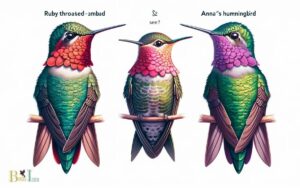Ruby Throated Hummingbird Heart Rate: 1200+ BPM!
The Ruby-Throated Hummingbird (Archilochus colubris) has an astonishingly high heart rate, with an average of over 1200 beats per minute when actively flying.
During rest or torpor, which is a state of deep sleep, their heart rate can slow to a mere 50-180 beats per minute.
The Ruby-Throated Hummingbird’s heart rate reflects its incredibly active lifestyle. Their rapid wing beats, which can exceed 50 times per second during flight, require a high metabolic rate to sustain, thus necessitating such a rapid heart rate.
This hummingbird species, like many others, can enter a state of torpor to conserve energy, significantly reducing its heart rate and metabolic functions.
During torpor, the hummingbird’s heart rate and body temperature decrease drastically, allowing it to conserve energy, especially during cold nights or when food is scarce.
Despite its diminutive size, the Ruby-Throated Hummingbird’s heart is a powerhouse, beating over 20 times per second during vigorous activity to fuel its high-speed maneuvers.

Key Takeaway
The Physiology of Hummingbird Hearts
When examining the physiology of hummingbird hearts, it becomes evident that their unique characteristics enable them to sustain an exceptionally high heart rate.
The remarkable ability of hummingbirds to maintain such a rapid heartbeat is attributed to several physiological adaptations.
- Firstly, their hearts are proportionally larger in comparison to their body size, allowing for greater efficiency in oxygen transport to support their high metabolic demands.
- Secondly, hummingbird hearts possess a unique ability to rapidly contract and relax, facilitating the rapid circulation of oxygenated blood throughout the body.
- Additionally, their hearts have a specialized conduction system that coordinates the rhythmic contractions, ensuring a continuous and efficient blood flow.
These physiological adaptations collectively contribute to the astonishing capacity of hummingbird hearts to sustain such elevated heart rates, enabling them to thrive in their energetic and agile lifestyle.
Factors Affecting Hummingbird Heart Rate
Factors affecting hummingbird heart rate include environmental temperature impact and feeding and activity levels.
Environmental temperature can have a significant influence on the metabolic rate of hummingbirds, thereby affecting their heart rate.
Additionally, the energy demands associated with feeding and activity levels can also play a role in modulating their heart rate.
Environmental Temperature Impact
The environmental temperature’s impact on the heart rate of the Ruby Throated Hummingbird is a critical factor in understanding the physiological responses of these birds.
As the temperature changes, so does the heart rate of the hummingbird. At lower temperatures, the heart rate decreases significantly as a mechanism to conserve energy.
Conversely, in higher temperatures, the heart rate increases to support the increased metabolic demands required for thermoregulation and sustained flight.
This ability to adjust their heart rate based on environmental temperature allows the Ruby Throated Hummingbird to thrive in a variety of habitats and ecological conditions.
Understanding these temperature-dependent fluctuations in heart rate is essential for comprehensively studying the adaptability and resilience of these remarkable birds.
This interplay between environmental temperature and heart rate sheds light on the remarkable physiological flexibility of the Ruby Throated Hummingbird.
Feeding and Activity Levels
Adapting to varying energy demands, the feeding and activity levels of Ruby Throated Hummingbirds contribute to the fluctuations in their heart rate, as influenced by environmental temperature.
These tiny birds have a high metabolic rate, requiring them to feed frequently. When foraging, their heart rates increase significantly to meet the energy demands of their rapid wing beats, which can reach up to 80 beats per second during flight.
Additionally, the heart rate of Ruby Throated Hummingbirds is closely linked to their activity levels. During periods of rest, such as at night or when perched, their heart rates decrease to conserve energy.
This dynamic relationship between feeding, activity, and heart rate showcases the intricate adaptations of these birds to maintain their high energy requirements.
Comparing Hummingbird Heart Rate to Other Birds
Comparing hummingbird heart rate to that of other birds reveals significant differences in metabolic demands and cardiovascular adaptations. Hummingbirds have the highest metabolism of all birds, which is reflected in their heart rates.
When compared to other bird species:
- Hummingbirds have an average heart rate of 1200 beats per minute during flight, whereas larger birds like pigeons maintain a heart rate of around 600 beats per minute in flight.
- This stark contrast in heart rate reflects the varying metabolic demands and energy requirements for sustained hovering flight versus gliding or soaring.
- Additionally, the unique ability of hummingbirds to enter torpor, a state of drastically reduced metabolic rate and heart rate, sets them apart from other birds, allowing them to conserve energy during periods of food scarcity or nighttime rest.
The Role of Heart Rate in Hummingbird Behavior
In relation to the previous subtopic, the heart rate of ruby-throated hummingbirds plays a crucial role in their unique behavioral adaptations and energy management.
Hummingbirds have an exceptionally high heart rate, ranging from 250 to 1200 beats per minute, to support their hovering flight and high metabolism.
This rapid heart rate is essential for meeting the energy demands of their active lifestyle, allowing them to sustain their incredibly fast wingbeats and rapid movements.
Additionally, hummingbirds exhibit substantial variation in heart rate during different activities such as foraging, resting, and during flight.
The ability to quickly adjust their heart rate enables them to efficiently regulate their energy expenditure and optimize their foraging efforts.
Understanding the intricate relationship between heart rate and behavior is fundamental in appreciating the remarkable adaptations that enable hummingbirds to thrive in their environments.
Adapting to High Heart Rates: Hummingbird Evolution
Hummingbirds have evolved to adapt to high heart rates, particularly crucial for their high-altitude lifestyles. The ability to maintain a rapid heart rate allows hummingbirds to thrive in their environment, providing them with an evolutionary advantage over other species.
Understanding the evolutionary mechanisms behind this adaptation sheds light on the remarkable resilience and specialization of hummingbirds.
High-Altitude Heart Adaptation
The high-altitude adaptation of the hummingbird heart involves a complex physiological response to sustain elevated heart rates necessary for survival at extreme elevations.
This adaptation is crucial for hummingbirds as they often inhabit high-altitude environments where oxygen levels are lower.
The following mechanisms enable hummingbirds to adapt to high heart rates at high altitudes:
- Enhanced oxygen-carrying capacity: Hummingbirds have higher hemoglobin concentration, allowing for more efficient oxygen transport in their blood.
- Increased cardiac efficiency: Their hearts are capable of greater stroke volumes, ensuring efficient circulation and oxygen delivery to tissues.
These physiological adaptations enable hummingbirds to thrive in high-altitude environments, where their elevated heart rates are essential for meeting the metabolic demands required for survival.
Evolutionary Advantage of Adaptation
Adapting to high heart rates has conferred an evolutionary advantage to hummingbirds, enabling their survival in high-altitude environments.
The ability to maintain a rapid heart rate allows these avian species to thrive in regions where oxygen levels are lower, such as mountainous areas.
Hummingbirds have developed physiological and metabolic adaptations that support their high heart rates, including specialized respiratory systems, efficient oxygen utilization, and unique hemoglobin properties.
These evolutionary traits provide them with the necessary energy to sustain their rapid heartbeats and hovering flight.
Furthermore, the high heart rate enables hummingbirds to efficiently forage for nectar, their primary food source, and evade predators.
This evolutionary advantage has allowed hummingbirds to occupy diverse ecological niches, contributing to their remarkable success as a species.
Monitoring Hummingbird Heart Rate in the Wild
When studying the heart rate of ruby-throated hummingbirds in their natural habitat, it is crucial to employ non-invasive monitoring techniques. This ensures minimal disturbance to the birds and accurate data collection.
The following techniques are commonly used for monitoring hummingbird heart rate in the wild:
Remote Photoplethysmography (PPG):
Utilizing a non-invasive optical technique to measure blood volume changes in peripheral circulation, PPG allows for the observation of heart rate without physical contact.
- Advantage: Minimizes stress on the hummingbirds by eliminating the need for direct contact.
- Limitation: Environmental conditions, such as lighting, can impact the accuracy of PPG measurements.
Radio Telemetry:
Using small, lightweight radio transmitters attached to the birds to remotely monitor their heart rate and activity patterns.
- Advantage: Provides continuous real-time data without disturbing the natural behavior of the hummingbirds.
- Limitation: Requires careful consideration of transmitter size and attachment method to ensure minimal impact on the birds’ mobility and well-being.
Conclusion
The ruby-throated hummingbird exhibits an extraordinary heart rate that surpasses that of most other birds. Its ability to sustain a high heart rate is a remarkable feat of adaptation, allowing it to support its rapid metabolism and high-energy lifestyle.
Further research into the factors influencing hummingbird heart rate and its role in behavior will continue to provide valuable insights into the physiological marvel of these tiny, yet powerful, creatures.






